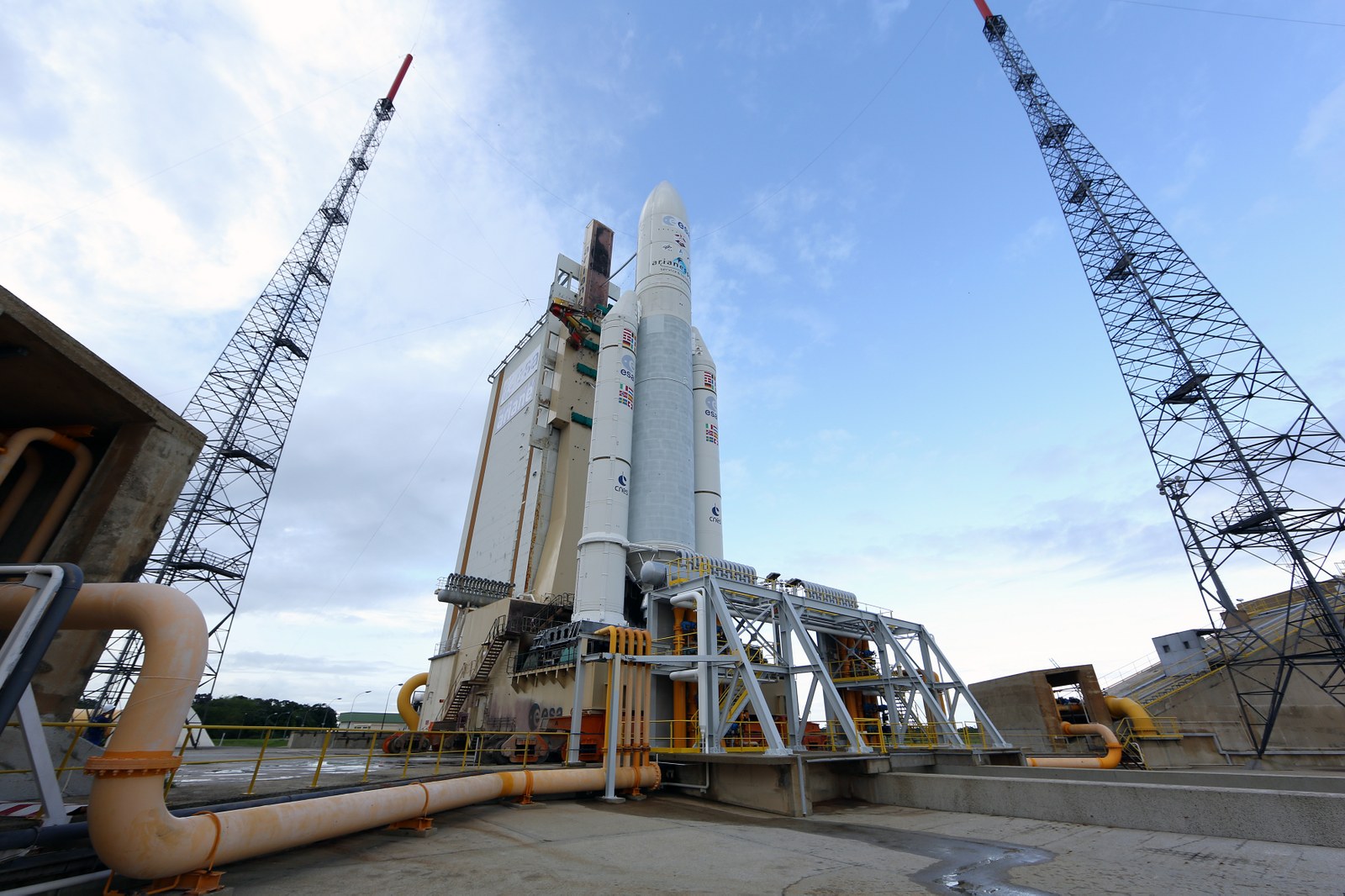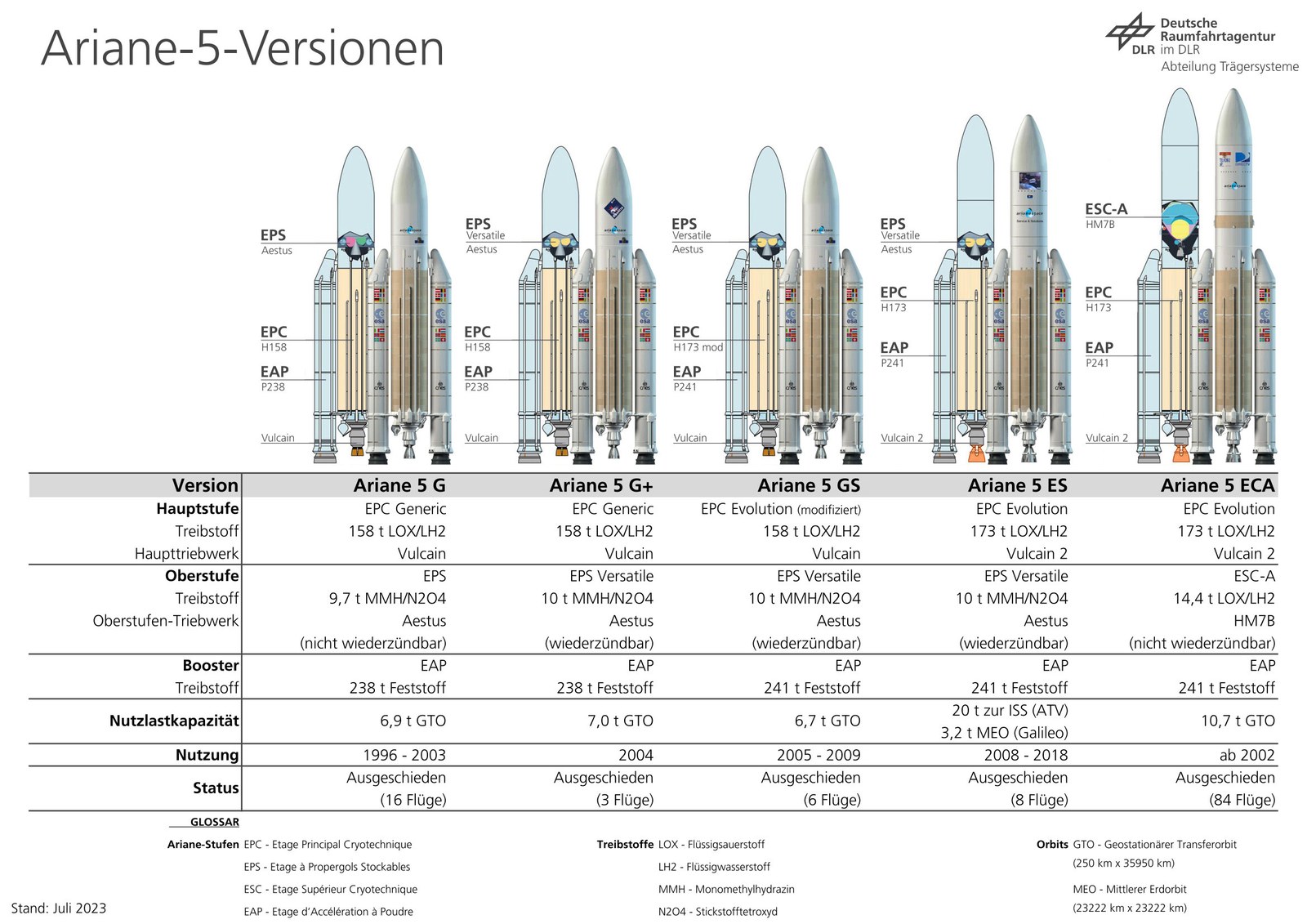Ariane 5
The three-stage heavy-lift rocket could transport a payload mass of up to 10.7 tonnes into geostationary transfer orbit and more than 20 tonnes into low Earth orbit. Ariane 5 was powered by two solid-propellant boosters, a main stage with a Vulcain engine and a re-ignitable upper stage with an Aestus engine. The final flight of Ariane 5 lifted off at 00:00 CEST on 6 July 2023, carrying the German communications satellite Heinrich Hertz and the French military satellite Syracuse 4B into geostationary transfer orbits.
Ariane 5 ECA
The Ariane 5 ECA, which weighed approximately 780 tonnes at lift-off, was the workhorse of European spaceflight and was one of the world’s most widely used launchers for many years. Its main task was to transport commercial communications satellites into geostationary transfer orbit. The approximately 17-metre-high payload fairing offered space for up to two satellites at the same time, but the Ariane 5 ECA could also be used to launch institutional satellites into much higher orbits. In December 2021, for example, Ariane 5 launched the successor to the famous Hubble Space Telescope, the James Webb Space Telescope. Up until the end of its operational phase, the Ariane 5 ECA underwent further development in order to maintain its competitiveness. The performance of the rocket was enhanced to meet requirements such as increasing satellite launch masses.

Ariane 5 ES

The Ariane 5 ES was primarily designed for flights in low and medium Earth orbit. The launcher transported the European Automated Transfer Vehicle (ATV) cargo spacecraft on their way to the International Space Station (ISS) between 2008 and 2014 and also twice orbited Galileo satellites in groups of four.
In November 2016, the launch vehicle brought European navigation system satellites into orbit at an altitude of approximately 23,600 kilometres for the first time. The Aestus upper stage engine is essential for these tasks because the ability to re-ignite is required both for approaching the ISS and for injecting Galileo navigation satellites into the required orbits.
The last launch of an Ariane 5 launcher took place in July 2023.
European cooperation on Ariane 5
The various components of Ariane 5 were built by leading companies in the space industry throughout Europe. The main German supplier was the company MT Aerospace, which supplied essential components for the launch system.
French company Arianespace was responsible for the operation and marketing of the launcher. The German Space Agency at DLR monitored the course of the Ariane 5 utilisation phase. This ESA programme was intended to ensure the competitiveness, cost-effectiveness and operational safety of the launcher.
The history of the Ariane launcher family
The very first flight of an Ariane 1 on 24 December 1979 from the European spaceport in Kourou, French Guiana, was a complete success. In the then-burgeoning commercial market segment, the Ariane launcher family quickly developed into a reliable, competitive and flexible space transport system. The operating company Arianespace soon gained global market leadership. From 1988 to 2003, Ariane 4 completed 116 flights with an impressively high success rate, winning the trust of international customers and transporting approximately 180 satellites into orbit. Ariane has shaped the commercial launcher market worldwide.
In the light of their ambitious space plan, ESA’s member states decided in November 1987 to begin development of a new generation of the launcher family – Ariane 5. The new heavy-lift rocket was designed to serve both the commercial satellite launch market and help resupply the proposed US ‘Freedom’ space station, which later became the ISS. Since then, many satellites belonging to ESA and other European institutions have been launched with Ariane. Ariane 5 guaranteed Europe independent access to space, for the benefit of all European states and large sectors of the economy until its final flight in July 2023.

Parameter Ariane 5 ECA
First launch | 11.12.2002 |
Last launch | 05.07.2023 |
Launch site | ELA-3, Centre Spatial Guyanais, Französisch-Guayana |
Height | 55 m |
Main diameter | 5,4 m |
Mass at launch | 780 t |
Payload capacity | 10,3 t to Geostationary Transfer Orbit (GTO) |
Typical payloads | Telecommunications, research and Earth observation satellites |
Stages
Solid-propellant boosters EAP | Cryogenic main stage EPC | Cryogenic upper stage ESC-A | |
Height | 31,6 m | 23,8 m | 4,7 m |
Diameter | 3,05 m | 5,4 m | 5,4 m |
Empty mass | 37 t | 14,7 t | 4,5 t |
Fuel mass | 240 t Hydroxyl-Terminated Polybutadiene | 146,2 t Liquid oxygen 23,8 t Liquid hydrogen | 12,8 t Liquid oxygen 2,1 t Liquid hydrogen |
Engine Thrust (vacuum) Specific impulse (vacuum) Firing time | N/A 7000 kN 275 s 130 s | Vulcain 2 1390 kN 432 s 540 s | HM7B 67 kN 446 s 945 s |

